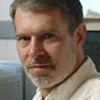
A. G. Cairns-Smith
Författare till Seven Clues to the Origin of Life: A Scientific Detective Story
Om författaren
A.G. Cairns-Smith is Honorary Senior Research Fellow in Chemistry at the University of Glasgow and a Fellow of the Royal Society of Edinburgh. He's the author of The Life Puzzle, Genetic Takeover, Seven Clues to the Origin of Life, and Evolving the Mind.
Verk av A. G. Cairns-Smith
Taggad
Allmänna fakta
- Namn enligt folkbokföringen
- Cairns-Smith, Alexander Graham
- Födelsedag
- 1931
- Kön
- male
- Nationalitet
- UK
- Bostadsorter
- Glasgow, Scotland, UK
- Yrken
- molecular biologist
Organic chemist
Medlemmar
Recensioner
Du skulle kanske också gilla
Statistik
- Verk
- 10
- Medlemmar
- 198
- Popularitet
- #110,929
- Betyg
- 3.6
- Recensioner
- 6
- ISBN
- 23
- Språk
- 5
- Favoritmärkt
- 1














The title encapsulates his main message and that is that somewhere along the line nucleotides and amino acids evolved from something else: something simpler and something that was mineral based. He espouses the view that there was some form of mineral evolution that provided the templates for organic chemicals to develop and reproduce and once this happened the organic chemicals just took over and supplanted their earlier mineral based ancestry. (And, apparently, in the process, erased the signs of this ancestry. This step was what Cains-Smith describers as 'genetic takeover".
He favours the idea that clays are ideal candidates for the precursors of organic chemicals...or, at very least, they could be templates for replication and growth. There is an overwhelming amount of information and detail in the book ...so much so that it is hard to take it all in.
I did come away with the impression that Cairns-Smith has an unending series of examples of ways things MIGHT have developed ....some of them rather far-fetched but possible. But he's very weak on real examples of sequences of events that lend weight to his case.
I did think that he might have made more out of some of the evolutionary sequencing that seems to occur with Kaolinite changing into Allosite or similar natural sequence and I would have liked to have seen some situations with a bit more detail like that suggested in Fig 9.5 (p383).
But maybe Cairns-Smith was not the right person to take the proposal to the next level and, unfortunately, nobody else seems to have stepped up to the plate in the last 50 years.
I recently read the book "First Life" by David Deamer and it seems to be the current state of the art with "origins of life" theory. But rather disappointing and there is virtually no mention of Cairns-Smiths ideas. In fact, Deamer reveals his profound ignorance of clays and their absorptive capacity by taking an experiment to a volcanic pool in Siberia and basically dropping it in to see what would happen. Seems very naive to me:.......the clay immediately grabbed (adsorbed) all his organic chemicals ...and that was that.
Somewhere in Cairn's writings, he mentions that he took his ideas to the USA: The geologists thought his geology was fine but weren't quite sure about his biochemistry; The biochemists were happy with the biochemistry but thought the geology might be a bit suspect; The Chemists were happy with the Chemistry but thought the Geology needed some work...etc. I think that Deamer has little or no knowledge of clay Chemistry and probably most scientists around today are similar in that their knowledge doesn't roam over as broad a field as Cairns-Smith is attempting to embrace. A pity, because I think that Cairns-Smith might actually be onto something here. I won't try to summarise his data or arguments....there is too much there. But I did find it a fascinating book and happy to give it 5 stars.… (mer)